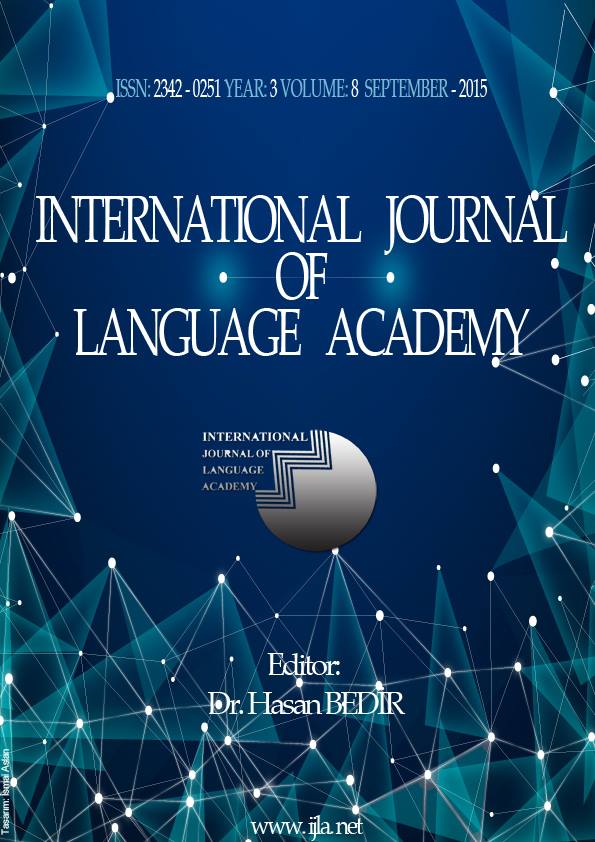Author :
Abstract
Bu araştırmada, yaratıcı yazma tekniklerinin yabancı dil olarak Türkçe öğretiminde kullanılmasının dil öğrenimindeki yazma becerisine katkı sağlayıp sağlamadığı incelenmiştir. Araştırma İstanbul Üniversitesi Dil Merkezi’nde Yoğunlaştırılmış Türkçe Kursu’na katılan B1 (n=42) ve C1(n=24) seviyesindeki öğrenciler (N=66) ile gerçekleştirilmiştir. Nicel araştırma boyutuna sahip olan çalışma beş hafta boyunca çalışma ve kontrol gruplarıyla ayrı ayrı yürütülmüştür. Deney grubuna (n=26) araştırmacı tarafından hazırlanan yaratıcı yazma programı haftada 2’şer saat uygulanmış; kontrol gruplarına (n=40) herhangi özel bir program uygulanmamış, sadece, Dil Merkezi’ndeki ders programlarına devam etmeleri sağlanmıştır. Araştırmada öntest sontest kontrol gruplu deneysel modelden yararlanılmıştır. Verilerin elde edilmesinde, “Avrupa Dil Gelişim Dosyası B1 ve C1 Düzeyleri Yazılı Anlatım Öz Değerlendirme Ölçeği”, öğrencilerin yazmaya karşı tutumlarını ölçmek amacıyla Susar Kırmızı (2009) tarafından geliştirilen “Yazı Yazmaya Yönelik Tutum Ölçeği” ve yaratıcı yazma ürünlerini değerlendirmek amacıyla “Yaratıcı Yazma Değerlendirme Ölçeği” kullanılmıştır. Elde edilen veriler Mann Whitney U Testi ve Wilcoxon İşaretli Sıralar Testi ile çözümlenmiştir. Araştırmanın sonucunda, yaratıcı yazma çalışmalarının B1 ve C1 seviyelerindeki yabancı dil olarak Türkçe öğrenen öğrencilerin yazmaya karşı tutumlarını olumlu yönde etkilediği, öz yeterlik algılarını arttırdığı ve yazma süreçlerini etkin hâle getirdiği görülmüştür.
Keywords
Abstract
In this research, it has been examined whether the use of creative writing techniques in teaching Turkish as a foreign language can contribute improving writing skills. This research has been carried out with B1 level (n=42) and C1 level (n=24) students, all of whom (N=66) attended to Intensive Turkish Courses at Istanbul University Language Center. This research, which is quantitative, continued 5 weeks and it has been performed on a study group and control group separately. The study group (n=26) were applied the creative writing program, which was designed by the researcher, 2 hours per week. The control group (n=40) wasn’t given any special program, but they continued their regular schedule at the Language Center. In the research, “the pre-test/ post-test control group experimental design” was used. In the process of obtaining data European Language Portfolio B1 and C1 Levels Written Expression Self-Efficacy Scale was used. In order to evaluate students' attitudes towards writing the Writing Attitude Scale, which was developed by Susar Kırmızı (2009), was used; and to evaluate their creative writing products Creative Writing Evaluation Scale was applied. The statistical analysis’s, which are Mann Whitney U Test and Wilcoxon Signed Rank Test, have been applied to the collected data. The following conclusions have been observed as a result of the research; creative writing studies that have been implemented on B1 and C1 level students of Turkish as a foreign language have positively affected students' attitudes towards writing and have enhanced students' self-efficacy perceptions and have made efficient the writing processes.
Keywords
- Avcı A. ve İşeri K. (2014). Yaratıcı Yazma Etkinliklerinin Sekizinci Sınıf Öğrencilerinin Yazma Eğilimleri ve Yazma Kaygılarına Etkisi. International Journal of Language Academy, 152-169.
- Brookes I. Marshall D. (2004). Good Writing Guide. New York: Harap Publishers.
- Brown, H. D. (2001). Teaching by Principles: An Interactive Approach to Language Pedagogy. London: Longman.
- Büyüköztürk, Ş. , Kılıç, E. Ç. , Akgün, Ö. E. , Karadeniz, Ş. ve Demirel F.(2008). Bilimsel Araştırma Yöntemleri. (İkinci Baskı). Ankara: Pegem Akademi Yayınları.
- Büyüköztürk, Ş. (2010). Sosyal Bilimler İçin Veri Analizi El Kitabı. (11. Baskı). Ankara: Pegem Akademi Yayıncılık.
- Demirel, Ö. (2007). Yabancı Dil Öğretimi. Ankara: Pegem Akademi Yayınları.
- Güleryüz, H. (2006). Yaratıcı Çocuk Edebiyatı. Ankara: Pegem Akademi Yayıncılık.
- Milli Eğitim Bakanlığı. (2006). Avrupa Dilleri İçin Ortak Başvuru Metni, Öğrenme-Öğretme- Değerlendirme. Ankara.
- Özdemir, E. (1994). Yazınsal Türler. Ankara: Ümit Yayıncılık.
- Özer, S ve Şahan, M (2011) Yaratıcı Yazma ve Yaratıcı Dramanın Türkçe Derslerinde Kullanımı ve Atölye Örnekleri. https://www.academia.edu/3227553/Yaratıcı_Yazma_ve_Yaratıcı_Dramanın_Türk çe_Derslerinde_Kullanımı_ve_Atölye_Örnekleri Erişim: 03.06.2012
- Özbay, M. (2009). Türkçe Özel Öğretim Yöntemleri 2. Ankara: Öncü Kitapevi.
- Öztürk, A. (Ed.). (2007). Çocukta Yaratıcılık ve Drama. Eskişehir: Anadolu Üniversitesi Yayınları
- Robinson, K (2003). Yaratıcılık Aklın Sınırlarını Aşmak. İstanbul: Kitap Yayınevi.
- San, İ. (2006). Sanat ve Yaratıcılık Eğitimi Olarak Tiyatro. Yaratıcı Drama 1985-1998 Yazıları, (Ed.Ö.H. Adıgüzel). (2. Baskı). Ankara: Naturel Kitap Yayın Dağıtım. s.1
- Senemoğlu, N. (2002). Gelişim Öğrenme ve Öğretim Kuramdan Uygulamaya. Ankara: Gazi Kitabevi.
- Sever, S. (2004). Türkçe Öğretimi ve Tam Öğrenme. (4. Baskı). Ankara: Anı Yayıncılık
- Susar Kırmızı, F. (2009). Türkçe Dersinde Yaratıcı Drama Yöntemine Dayalı Yaratıcı Yazma Çalışmalarının Yazmaya Yönelik Tutuma Etkisi. Yaratıcı Drama Dergisi. Cilt 2, Sayı 5, 159-177.
- Tonyalı, E. (2010). Yaratıcı Yazma Uygulamalarının İlköğretim Altıncı Sınıf Öğrencilerinin Yazma Becerilerine Etkisi. (Yayınlanmamış Yüksek Lisans Tezi) Bolu: Abant İzzet Baysal Üniversitesi, Sosyal Bilimler Enstitüsü.





